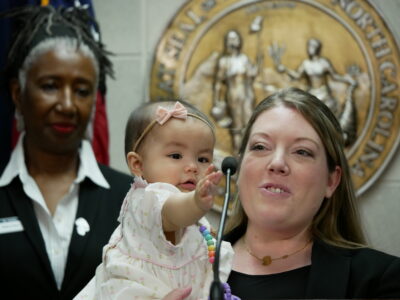
|
|
Gov. Roy Cooper and nine other governors sent a letter to Congress on Tuesday calling for more federal funding for child care as pandemic relief funds dry up. North Carolina tied with Vermont and Arizona for the highest percentage of families with work disruptions caused by a lack of child care in 2020-21, a new report says.
The letter asks Congress to maintain current levels of relief funding and to increase recurring funding in the federal budget for 2024 to ensure that working families have options.
“Of the many funding priorities before you, few are as critical to America’s working families as ensuring access to child care,” the letter reads. “Quality child care makes it possible for parents to work and employers to hire, all while giving young children a strong foundation to learn and thrive.”
In 2020-21, 16% of North Carolina children under 6 years old lived in families where someone quit, changed, or refused a job because of problems with child care. That’s higher than the national average of 13% and every other state except Vermont and Arizona, according to a 50-state report on child well-being — the 2023 Kids Count Data Book — released Tuesday night by the Annie E. Casey Foundation.
It’s also higher than every state represented in the letter to Congress.
“Across the country, businesses and employers are ringing the alarm that the shortage of available child care options is hurting our economy,” reads the letter, signed by Cooper and the governors of Colorado, Hawaii, Wisconsin, New Mexico, New Jersey, Washington, Kansas, Rhode Island, and Illinois.
Every year, the Kids Count Data Book ranks states in four domains: economic well-being, education, health, and community and family.
The focus on the lack of child care is specific to this year. The foundation wanted to highlight “how expensive, hard-to-find child care short-changes children and affects parents, costing the American economy billions of dollars a year, impeding women professionally and wreaking financial havoc on families.”
What can be done, from Kids Count
The report recommends:
- More child care funding from federal, state, and local governments. It says governments should maximize the remaining federal dollars from the American Rescue Plan Act and increase funding for child care subsidies that help working families afford child care, pre-K, and Head Start. On the federal level, it calls for policymakers to reauthorize and strengthen the Child and Development Block Grant Act, which goes to states to expand access to high-quality child care.
- Start-up support for family child care providers from public and private entities. The report says governments should get rid of any unnecessary barriers to capital for new providers and current ones. It says policymakers should encourage networks of family child care homes to reduce isolation and costs and increase access to professional development.
- More funding for the federal Child Care Access Means Parents in School program to support parents who are students. It calls for the higher education and business communities to find ways to locate child care programs on campuses and work sites to reduce barriers for families.
There is work by advocates, educators, business leaders, and policymakers in North Carolina in these three areas. Read more below:
Other state rankings
The Data Book ranked North Carolina 27th in economic well-being, noting the state’s percentage of children who live in poverty (18%) declined from 2019 to 2021. It’s 17% nationally.
North Carolina came in 23rd in education, with measures like the percentage of 3- and 4-year-olds not in school, fourth-graders not reading proficiently, and eighth-graders not proficient in math getting worse since 2019.
North Carolina ranked relatively worse in health (34th) and family and community (35th). The percentage of low birth-weight babies was 9.4%, up from 9.3% in 2019, compared with 8.5% nationally. In the “family and community” domain, the state improved in each measure, including children in single-parent homes (36%), children in families where the household head lacks a high school diploma (11%), children living in high-poverty areas (7%), and teen births per 1,000 (16).




